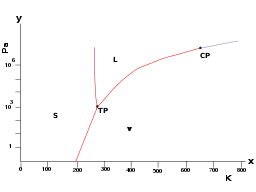< AP Chemistry 

Phase Diagrams
All three phases exist at the triple point. Critical point is where the substance is neither gas nor liquid.
Intermolecular Forces That Cause Ideal Gas Theory to Fail
- Polar substances - are more positive at one end and more negative at the other. Note that a compound may have polar bonds without being polar as a whole (if the poles cancel out).
- Hydrogen bonding - occurs when hydrogen bonds to N, O, or F. This is what gives water its unusual characteristics (high boiling point, heat capacity, and heat of vaporization, the fact that ice floats)
- London Dispersion - this occurs in massive, nonpolar substances, where a temporary electron asymmetry creates a dipole.
Liquids
- Surface tension is stronger in polar compounds.
- Viscosity is how "sticky" the substance is.
- Capillary action - the attraction of a polar substance to a nonpolar causing it to rise up a narrow tube for instance
Solids
- Amorphous solids are just viscous liquids. Very viscous liquids. E.g. Petroleum-derived pitch.
- Crystal lattices are made up of repeated unit cells.
- Metallic solids have a "sea" of decentralized electrons, which is why metals conduct electricity.
- Covalent network solids are basically one huge molecule made from repeating smaller molecules. Examples include (SiO2)x, SiC, graphite
This article is issued from Wikibooks. The text is licensed under Creative Commons - Attribution - Sharealike. Additional terms may apply for the media files.